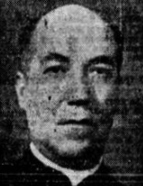

Paulo Florêncio da Silveira Camargo was born on 25 January 1896 in Cabreúva, São Paulo. He was the son of Pedro Florêncio da Silveira Júnior, a merchant, and Rosa Lina de Almeida Camargo. He completed his early studies in the nearby city of Itu, known as the "Brazilian Rome" in the late 19th century due to the Church's significant influence— particularly that of the Jesuits— on the city’s organisation and local politics. He studied at the Cesário Motta School Group and the São Luís College, a Jesuit institution founded in 1867. In 1911, he entered the Minor Seminary of Pirapora. After finishing school, he continued his studies at the Seminário Provincial de São Paulo [Provincial Seminary of São Paulo], now the Seminário Central do Ipiranga [Central Seminary of Ipiranga] (Correio Paulistano, Bodas de prata sacerdotais, 1946, p. 5).
With several relatives in the clergy, Camargo was ordained as a priest in 1921. From 1922 to 1924, he served as curate in the parish of St. John the Baptist. He then became vicar in Santana de Parnaíba, where he chaired the committee for the tercentenary celebration of the founding of the village that later became the city. Drawing from his studies while serving as vicar, he published Notas para a história de Parnahyba [Notes for the History of Parnahyba] (1935), which he later revised and expanded as História de Santana de Parnaíba [History of Santana de Parnaíba] (1971). In these works, the author narrates the role of the bandeirantes (settlers) in founding the village and developing the region, as well as the Church's involvement. In both books, he stated that "pas de documents, pas d'histoire" (“no documents, no history”). Although he did not explicitly reference Introduction aux études historiques (1898) by Charles-Victor Langlois and Charles Seignobos, his use of the French expression reflects the influence of the Methodical School. Despite this empirical approach, however, Paulo Florêncio da Silveira Camargo’s narrative was largely apologetic toward the Church, which may explain, for instance, his omission of the presence of Moors and Jews among the founders of Santana do Parnaíba— kinship ties noted by José Gonçalves Salvador ( Os cristãos-novos..., 1976).
This work is financed by national funds through FCT - Foundation for Science and Technology, I.P, in the scope of the projects UIDB/04311/2020 and UIDP/04311/2020.
